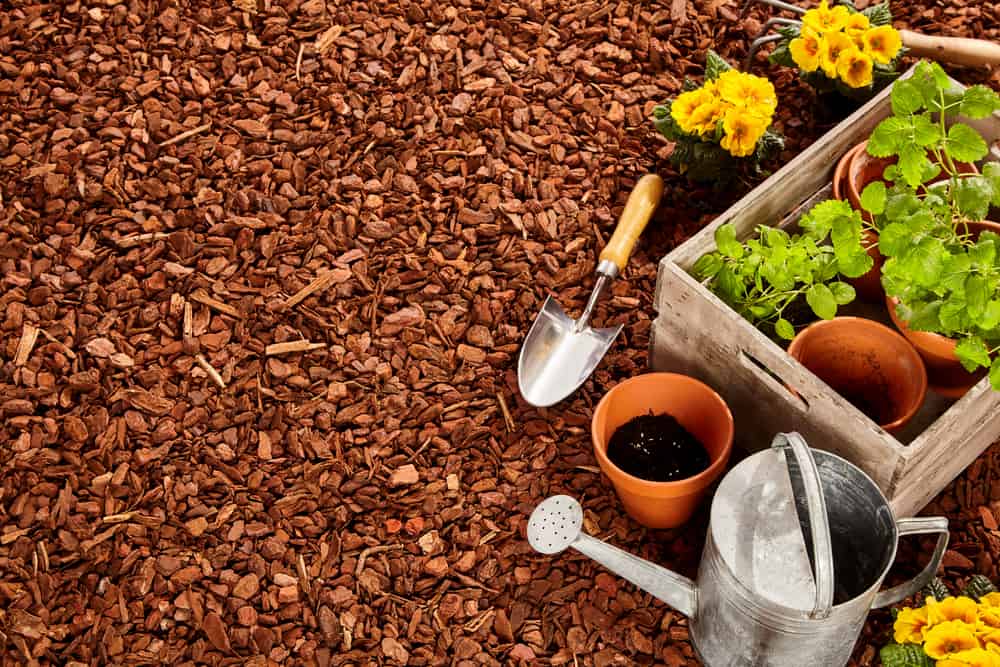Mulch. Yes, there it is. Again.
This time, let’s discuss the types of mulches and some of the properties. You can think of mulch as forming two categories: organic and inorganic. Of course, it comes in a wide variety of both, but the shared purpose of any mulch is to improve soil conditions.
Mulch isn’t a miracle cure for all your garden’s problems, but it can help with many of the problems your garden might experience. It can increase moisture retention at the plant’s roots, where it’s most needed. It can help drainage in bedding areas so water won’t puddle on top of the soil.
Mulch can offer protection from both the winter cold and the summer heat. It prevents damage by insulating the soil when temperatures become extreme. Making a thick layer of organic mulch in bedding and around woody plants, like trees and shrubs, can insulate the plant’s roots while winter progresses.
Mulches can benefit gardens, trees, and plants; it keeps moisture where it’s needed, helps prevent soil compaction, and can protect sensitive plants from mowers and weed whackers.
You can change the whole look of your landscape by using a different color or texture of mulch from year to year. Spring or fall clean-up time is usually ideal for making those changes. During clean-up times, your landscape partners, Divine Lawns, will evaluate your mulched areas and recommend new mulches if there has been enough degradation of the organic mulches to make them less effective.
Organic mulches
Organic mulches are more popular with landscape pros than inorganic mulches because they can offer more benefits to the soil. However, organic mulches will decompose and require removal and replacement regularly.
Some of the most popular organic mulches include:
- Wood chips or bark – these are byproducts of lumber and paper industries and are usually dried, may be dyed, and aged to be most beneficial.
- Straw – clean straw from wheat, barley, and oats is used for light mulching. It can help keep grass seed from washing away or being eaten by birds. But don’t confuse straw with hay – hay contains a seed that could sprout later in the season.
- Grass clippings or shredded leaves – These are very suitable for light mulching, and you can make it yourself! But beware, thin layers only, as it can mat and create other problems.
- Shredded newspaper or cardboard – good weed control. Be careful not to use any of the print media with colored print, as the chemicals can contain toxic dye. Cover it with a light layer of shredded leaves or grass clippings to keep it from blowing away.
- Cocoa chips – Mmmmm, can you smell it? Divine! Cocoa bean hulls are lightweight mulch applied in a thin (not more than one inch) layer. They will decompose quickly, though, so be careful not to over-water. Avoid using this mulch if you have pets or wildlife roaming your area since chocolate can be very bad or fatal to animals.
- Composted animal manure – you’ve been waiting for this one, haven’t you? Be cautious, though; fresh manure can burn sensitive plant roots. Also, avoid using pet manure, or manure from pigs, as these might have disease-causing organisms.
Think of the lovely mulch it will make for your plants this spring if you are into composting!
Inorganic mulches
Inorganic mulches can look very good, but they can’t retain moisture, and they can heat up relatively fast. The extra heat may cause heat stress to plants, burning the root systems. Use this cautiously.
However, it’s trendy for use in areas where you might not want anything to grow, as it can prevent weeds and other growth. And it can look terrific as a border for walkways and patios and other hard-scaped areas or as walkways or paths.
Some types of inorganic mulch include:
- Rocks or rock dust – marble chips, gravel, and pea gravel. Please don’t use these around trees, as they can cause overheating and damage. On the upside, these don’t break down, so it’s a one-time application. On the downside, these don’t break down, so it’s a one-time application. What if you want to change your mind after a hundred years or so?
- Landscape plastic or fabric – plastic is suitable for weed control since water and nutrients can’t be passed through, and it will have to be replaced at the end of every growing season. Landscape fabric is better for long-term use and does well with a layer of organic mulch (wood chips) over it. Some gardeners make holes in the soil to dig their plants directly into the soil.
- Rubber – usually made from recycled tires. It’s inexpensive and used for playground areas because of its durability. Not great for home landscaping since it does not decompose, and it might have toxins in the rubber that can reach the soil.
It’s all about the mulch.
As you know, mulch can be essential for the north and the plains’ brutal winters. Cold weather can come charging out of nowhere and devastate a garden or flower bed that hasn’t been prepared.
Talk with your Divine Lawns landscape professionals to have your mulching needs to be evaluated and about a schedule for replacing mulches that degrade. Changing a mulch for color is famous for many gardeners, as it can provide contrast and interest when viewed from the street or road.
Close-up, mulch can help define areas for play and outside activities for children. Giving them a small backyard plot to do with as they want and a supply of seeds and mulch for growing things will increase their curiosity and fascination. Root vegetables are especially easy to grow. Just try not to laugh aloud as your toddler pulls up her carrots to inspect them for growth every day.
Divine Lawns is happy to guide you and your family in producing healthy plants for beauty and your table.
 (316) 435-3509
(316) 435-3509 office@divine-lawns.com
office@divine-lawns.com
